The Spanish organizers por un lado, por otro lado and discursive overmarking: An experimental study
IF 1.7
1区 文学
0 LANGUAGE & LINGUISTICS
引用次数: 0
Abstract
The Spanish correlative pair por un lado (Eng. ‘on the one hand’) and por otro lado (Eng. ‘on the other hand’) fulfill an informative structuring function: it presents two subcomments and organizes them under the same topic. Its procedural meaning does not provide a clear instruction on the argumentative orientation of the cohesive segments. Thus, they can be used both in argumentatively co-oriented and anti-oriented contexts, depending on the argumentative orientation raised by the conceptual words that make up the segments in the discourse. However, two self-paced reading experiments (grammatical judgement and production) that were carried out with 95 and 60 native speakers of Spanish, respectively, show that the degree of acceptability differs according to whether this correlative pair of markers is used in contexts of argumentative co-orientation or anti-orientation. Results suggest that the use of this pair in argumentatively co-oriented segment may result in overmarking if the volume of information is not relevant.
西班牙组织者的穷学生,穷学生和话语过度:一项实验研究
西班牙语相关词por un lado(英文)。‘ on one hand ’)和poor otro lado(英语。“另一方面”)实现了信息结构功能:它呈现了两个子评论,并将它们组织在同一个主题下。它的程序意义并没有对衔接语段的论证方向提供明确的指导。因此,根据构成语篇片段的概念词所提出的论证倾向,它们既可以用于同向论证语境,也可以用于反向论证语境。然而,分别对95名和60名西班牙语母语者进行的两项自定节奏阅读实验(语法判断和生成)表明,这对相关标记是在议论文共取向语境中使用还是在反取向语境中使用,可接受程度也有所不同。结果表明,如果信息量不相关,在共同导向的议论文段中使用这对可能会导致过度标记。
本文章由计算机程序翻译,如有差异,请以英文原文为准。
求助全文
约1分钟内获得全文
求助全文
来源期刊

Journal of Pragmatics
Multiple-
CiteScore
3.90
自引率
18.80%
发文量
219
期刊介绍:
Since 1977, the Journal of Pragmatics has provided a forum for bringing together a wide range of research in pragmatics, including cognitive pragmatics, corpus pragmatics, experimental pragmatics, historical pragmatics, interpersonal pragmatics, multimodal pragmatics, sociopragmatics, theoretical pragmatics and related fields. Our aim is to publish innovative pragmatic scholarship from all perspectives, which contributes to theories of how speakers produce and interpret language in different contexts drawing on attested data from a wide range of languages/cultures in different parts of the world. The Journal of Pragmatics also encourages work that uses attested language data to explore the relationship between pragmatics and neighbouring research areas such as semantics, discourse analysis, conversation analysis and ethnomethodology, interactional linguistics, sociolinguistics, linguistic anthropology, media studies, psychology, sociology, and the philosophy of language. Alongside full-length articles, discussion notes and book reviews, the journal welcomes proposals for high quality special issues in all areas of pragmatics which make a significant contribution to a topical or developing area at the cutting-edge of research.
 求助内容:
求助内容: 应助结果提醒方式:
应助结果提醒方式:


